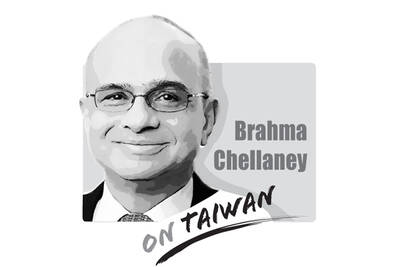It is certain that Democratic Progressive Party (DPP) Chairperson Tsai Ing-wen (蔡英文) will run as the party’s presidential candidate next year and this has attracted overwhelming “well-intentioned” suggestions — as well as intimidation — from the pan-blue camp and media outlets. They demanded that to maintain peace and stability across the Taiwan Strait, Tsai must accept the so-called “1992 consensus” in general or offer an alternative such as “constitutional one China.”
The “1992 consensus” refers to a tacit understanding between the Chinese Nationalist Party (KMT) and Beijing that both sides of the Strait acknowledge there is “one China,” with each side having its own interpretation of what “China” means.
In response to Tsai’s decision to run for president, Beijing also said that anti-Taiwanese independence and insistence on the “1992 consensus” are its bottom line — an ultimatum, it seems.
The question is: Is it true that without the “1992 consensus,” there will be no cross-strait relations or exchanges? Cross-strait exchanges began on Dec. 2, 1987, when the government allowed people to visit relatives in China. In October 1990, the government permitted indirect Taiwanese investment in China. In the 1990s, Taiwanese were visiting China and investments were growing even before the idea of a “1992 consensus” existed.
In 2000, the DPP became the ruling party, greatly loosening restrictions on Taiwanese investment in China and cross-strait travel. Still nobody talked about the “consensus.” Nor was it a requirement for implementing the “small three links” or weekend direct cross-strait flights. On the contrary, the over-liberalization of cross-strait relations abruptly killed off Taiwan’s economic momentum, resulting in the second transition of power.
In 2008, the KMT took office again. To please Beijing, President Ma Ying-jeou’s (馬英九) administration appended the “1992 consensus” to what had been normal cross-strait relations. The only reason for the KMT’s move was to provide a mechanism for Taiwan to jump on the China bandwagon.
Had Ma’s policy been successful, he would not have started the political tussle in 2013 to oust Legislative Speaker Wang Jin-pyng (王金平), the Sunflower movement would not have taken place nor would there have been a pan-blue rout in last year’s nine-in-one elections. Cross-strait relations under the “1992 consensus” have proven to be a poor facilitator of mutual trust, because any imposed requirement implies inequality. That is the reason Taiwanese do not trust the Ma administration and are wary of cross-strait relations.
Beijing forcing the “1992 consensus” on the DPP is the same as asking Taiwanese to agree upon a treaty while thousands of Chinese missiles are pointed at the nation. There is no discussion, let alone mutual trust.
Economically speaking, cross-strait policy under the “1992 consensus” has been disastrous. Ma’s failure to deliver his “6-3-3” campaign pledge is an inevitable result because the “one China” policy means there is only one market: China. For the previous six years, Taiwan has been marginalized, resulting in a depressed economy that can only afford a minimum wage of NT$22,000 per worker and produce a mere 2.9 percent economic growth rate, making Ma the worst economic performer among all the nation’s presidents.
The “1992 consensus” is not the foundation on which to build cross-strait relations. On the contrary, it destroys the harmony of cross-strait ties. A cross-strait relationship without the “1992 consensus” is the right path, facilitating peace and mutual trust, and bringing prosperity back to Taiwan. The prospects of the younger generation depend on it.
Huang Tien-lin is a former national policy adviser.
Translated by Ethan Zhan

As strategic tensions escalate across the vast Indo-Pacific region, Taiwan has emerged as more than a potential flashpoint. It is the fulcrum upon which the credibility of the evolving American-led strategy of integrated deterrence now rests. How the US and regional powers like Japan respond to Taiwan’s defense, and how credible the deterrent against Chinese aggression proves to be, will profoundly shape the Indo-Pacific security architecture for years to come. A successful defense of Taiwan through strengthened deterrence in the Indo-Pacific would enhance the credibility of the US-led alliance system and underpin America’s global preeminence, while a failure of integrated deterrence would
It is being said every second day: The ongoing recall campaign in Taiwan — where citizens are trying to collect enough signatures to trigger re-elections for a number of Chinese Nationalist Party (KMT) legislators — is orchestrated by the Democratic Progressive Party (DPP), or even President William Lai (賴清德) himself. The KMT makes the claim, and foreign media and analysts repeat it. However, they never show any proof — because there is not any. It is alarming how easily academics, journalists and experts toss around claims that amount to accusing a democratic government of conspiracy — without a shred of evidence. These
Taiwan is confronting escalating threats from its behemoth neighbor. Last month, the Chinese People’s Liberation Army conducted live-fire drills in the East China Sea, practicing blockades and precision strikes on simulated targets, while its escalating cyberattacks targeting government, financial and telecommunication systems threaten to disrupt Taiwan’s digital infrastructure. The mounting geopolitical pressure underscores Taiwan’s need to strengthen its defense capabilities to deter possible aggression and improve civilian preparedness. The consequences of inadequate preparation have been made all too clear by the tragic situation in Ukraine. Taiwan can build on its successful COVID-19 response, marked by effective planning and execution, to enhance
Since taking office, US President Donald Trump has upheld the core goals of “making America safer, stronger, and more prosperous,” fully implementing an “America first” policy. Countries have responded cautiously to the fresh style and rapid pace of the new Trump administration. The US has prioritized reindustrialization, building a stronger US role in the Indo-Pacific, and countering China’s malicious influence. This has created a high degree of alignment between the interests of Taiwan and the US in security, economics, technology and other spheres. Taiwan must properly understand the Trump administration’s intentions and coordinate, connect and correspond with US strategic goals.